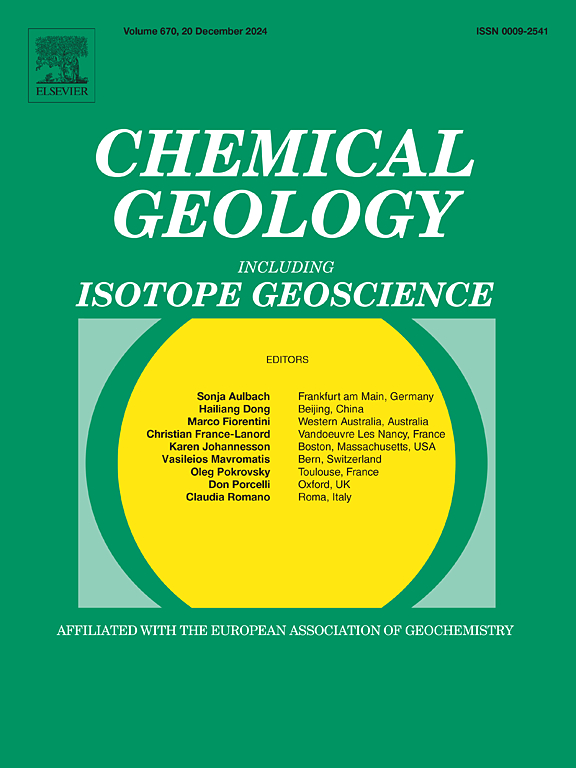利用LA-ICPMS/MS对黄铁矿、磁黄铁矿和黄铜矿进行原位硫同位素结构表征
IF 3.6
2区 地球科学
Q1 GEOCHEMISTRY & GEOPHYSICS
引用次数: 0
摘要
近年来,对原位硫同位素分析的需求有所增加。然而,目前还没有一种快速的方法可以在最小的样品制备时间内收集高分辨率的纹理约束数据。在这项研究中,我们开发了一种使用LA-ICP-MS/MS的分析技术,通过质量转移去除对32S和34S质量的干扰,快速获得薄片硫化物中的原位δ34S测量值。这种新方法需要开发与黄铁矿、磁黄铁矿和黄铜矿基质匹配的标准物质。在使用高精度大块SF6同位素比质谱(IRMS)和原位二次离子质谱(SIMS) S同位素方法进行分析之前,对新标准物质进行了岩石学和化学表征。新标准物质为伊比利亚黄铁矿(δ34S = 8.9 ± 1.1 ‰;Δ33年代 = −0.02±0.06 ‰),沙利文黄铁矿(δ34 s = 6.0 ± 0.6‰;Δ33年代 = −0.05±0.05 ‰),1869黄铜矿(δ34 s = 9.4 ± 0.2‰;Δ33年代 = −0.03±0.04 ‰),皮埃尔磁黄铁矿(δ34 s = 4.7 ± 0.2‰;Δ33年代 = −0.01±0.06 ‰),和蒙彼利埃磁黄铁矿(δ34 s = 3.3 ± 0.2‰;Δ33年代 = 0.18 ±0.07 ‰)。使用所建立的方法,每次分析运行期间主要标准物质的重现性近似为±1.5-2.0 ‰。该方法在SIMS先前测量的硫化物上进行了测试,得到的δ34S值在误差范围内,证实了该技术的稳健性。我们将该方法应用于秘鲁Cerro de Pasco矿床的黄铁矿-辉石黄铜矿脉,这是一个与斑岩有关的浅成热液多金属矿床。结果产生重硫同位素签名在微量元素(TE)纯度的浓缩铀的黄铁矿域(34 s δ= 2.2 ±1.1 ‰)和轻值(δ34 s = −1.2±1.7 ‰)在TE-depleted域。粒度S同位素变化与微观结构和TE内部分带耦合,解释为岩浆蒸汽凝聚的连续脉冲。本研究为各种含硫化物地质系统中具有岩石学特征的薄片的快速原位硫同位素分析开辟了新的分析机会。本文章由计算机程序翻译,如有差异,请以英文原文为准。
In situ sulfur isotopes in texturally characterized pyrite, pyrrhotite and chalcopyrite by LA-ICPMS/MS for application in sulfide bearing systems
The demand for in situ sulfur isotopes analysis has increased in recent years. Yet, no rapid method for collecting high-resolution texturally-constrained data with minimal sample preparation time has been available. In this study, we develop an analytical technique using LA-ICP-MS/MS to rapidly acquire in situ δ34S measurements in thin section-hosted sulfides by removing interferences on the 32S and 34S mass via mass shifting. This new method required the development of matrix-matched reference material for pyrite, pyrrhotite, and chalcopyrite. New reference materials have been petrographically and chemically characterized, prior to being analysed by both high-precision bulk SF6 isotope ratio mass spectrometry (IRMS) and in situ secondary ion mass spectrometry (SIMS) S isotope methods. The new reference materials include Iberia pyrite (δ34S = 8.9 ± 1.1 ‰; Δ33S = −0.02 ± 0.06 ‰), Sullivan pyrite (δ34S = 6.0 ± 0.6 ‰; Δ33S = −0.05 ± 0.05 ‰), 1869 chalcopyrite (δ34S = 9.4 ± 0.2 ‰; Δ33S = −0.03 ± 0.04 ‰), Pierre pyrrhotite (δ34S = 4.7 ± 0.2 ‰; Δ33S = −0.01 ± 0.06 ‰), and Montpellier pyrrhotite (δ34S = 3.3 ± 0.2 ‰; Δ33S = 0.18 ± 0.07 ‰). Using the developed method, the reproducibility of the primary reference material during each analytical run approximates ±1.5–2.0 ‰. The method was tested on sulfides previously measured by SIMS, with δ34S values yielded being within-error of these, confirming the robustness of the technique. We apply the method to case study pyrite-enargite chalcopyrite veins from Cerro de Pasco deposit, Peru, a porphyry related epithermal polymetallic deposit. The results yield heavier sulfur isotope signatures in trace element (TE)-enriched pyrite domains (δ34S = 2.2 ± 1.1 ‰) and lighter values (δ34S = −1.2 ± 1.7 ‰) in TE-depleted domains. The grain-scale S isotope variation is coupled to microstructure and TE internal zonation, and is interpreted to indicate successive pulses of condensed magmatic vapour. This study opens new analytical opportunities for rapid in situ sulfur isotope analysis in petrographically-characterized thin sections in various sulfide-bearing geological systems.
求助全文
通过发布文献求助,成功后即可免费获取论文全文。
去求助
来源期刊

Chemical Geology
地学-地球化学与地球物理
CiteScore
7.20
自引率
10.30%
发文量
374
审稿时长
3.6 months
期刊介绍:
Chemical Geology is an international journal that publishes original research papers on isotopic and elemental geochemistry, geochronology and cosmochemistry.
The Journal focuses on chemical processes in igneous, metamorphic, and sedimentary petrology, low- and high-temperature aqueous solutions, biogeochemistry, the environment and cosmochemistry.
Papers that are field, experimentally, or computationally based are appropriate if they are of broad international interest. The Journal generally does not publish papers that are primarily of regional or local interest, or which are primarily focused on remediation and applied geochemistry.
The Journal also welcomes innovative papers dealing with significant analytical advances that are of wide interest in the community and extend significantly beyond the scope of what would be included in the methods section of a standard research paper.
 求助内容:
求助内容: 应助结果提醒方式:
应助结果提醒方式:


